A Paipo
Interview with Luiz Antonio Pereira
March - April, 2013 - Brazil
Interview by Bob Green
INTRODUCTION. Before
fiberglass surfboards were made and ridden in
Brazil, bodysurfing and bellyboards were popular. Jacaré,
literally "to catch alligator," was a brand of bellyboard but also
slang for bodysurfing. Luiz Antonio Pereira recalls these early
surfing days in Brazil, when to "catch the alligator" was one of the
main forms of enjoying waves. Many early Brazilian surfers were both
spearfishermen and surfers. Luiz is also a well known freediving
spearfisherman who
has dived around the world as well as being involved in Brazilian and
international spearfishing organizations.
|
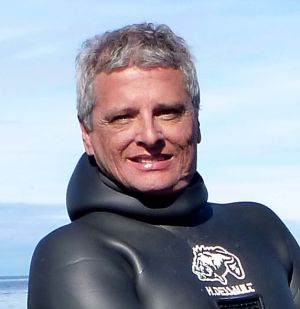
Luiz started freediving at
age 14. Photo
courtesy Luiz Antonio
Pereira. |
|
1.
In the film, Italian Summer 1948 [see Note a], there is some video footage of some small wooden boards. Are these
boards similar to the ones used in Basil?
In the beginning they were similar to those on
the video. My father was a belly surfer in the 1940s, and there were no
fins yet. According to him they were made of plywood by a bloke in his
neighborhood, Leme (an extension of Copacabana Beach). Those first
boards had a brand-name, Jacaré, (alligator in Portuguese). Pegar jacaré means to catch alligator. The expression came
before the brand-name wooden board from the 1940s. Swim fins arrived in
the late-1940s, and the Jacaré evolved to have a slightly curved
upwards nose and hand slots on the sides. The latter were made by a
factory, but I don't recall the name. They began to disappear in the
late-1950s, when actual surfing arrived here and serious surfers migrated
to it. In my very early teen years I was bodysurfing (just swim fins), then
I had a fiberglass longboard, made by São Conrado Surfboards,
the first Brazilian manufacturer of GRP surfboards.
The photo caption states, "I
smiled, remembering the pleasure of gliding over the waves, as in
Hawaii."
In the background a surfrider holds a curved nose board. It is not
clear whether the board in the foreground is flat-rockered or has a
rockered nose.
"O deslisador. Sorri, lembrando-se do prazer de deslisar sobre as ondas, como em Hawaii."

Unknown photographer. (1939, October 28). Beira-Mar. n. 656, p.20, from Bibliotecha
Nacional Digital Basil. Courtesy of Paulo Donadio Baptista.
What is your father's name and do you know the name of
the neighbor who made the boards?
His name is Luiz Humberto Pereira. He was just a common boy from Rio who
liked to go to the beach. He doesn't remember the name of board maker.
2. Is the factory that made the curve nosed boards the
same factory that also made spearfishing boats? Do you recall any
details of the factory (e.g., the location or who owned it) or who might
recall such details?
As fas as I know, the marine carpenter (not a
factory) was Moacyr Silva. He made plywood surfboards in the early-1960s.
But quit doing them soon after the establishment of a Clark Foam
Brazilian distributor. Moacyr continued making spearfishing wooden
boats until the early-1980s, when he retired and moved to another state,
in NE Brazil. The city district where his shop was located is now a
runaway of the international airport.
3. When you mentioned your early teens, around what year
was this?
1967 onwards. I was born in 1956. I got a nice
surfboard on my 13th birthday, but the bloody thing was so big I
couldn't carry it alone to the beach, so I kept on bodysurfing. I took up
spearfishing at 14, and gradually stopped surfing.
4. Do you know anyone else who would remember these
boards?
I suggest you contact Arduino Colasanti a
surfing pioneer and former spearfishing champion. He was a famous movie
star in the 1960s and 1970s. [Learn more about Colasanti in Note 2.] Check this out,
very interesting statement by Irencyr Beltrão, aka Barriguinha
("Little Belly"), mentioned in this piece, is a friend of mine. Luiz
Carlos Vital, aka Bisão ("Bison") was a friend of my father and
former president of my club, Clube dos Marimbás. According to
Irencyr, Bisão hired a carpenter to make the rectangular board
you see in the picture with Arduino. [Also see Irencyr's comments on early waveriders in Note 3.]
(Below left) Arduino
Colasanti with the rectangular board made for Luiz Carlos Vital.
(Below right)
Madeirite heading out.
|
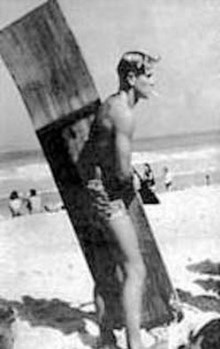 |
|
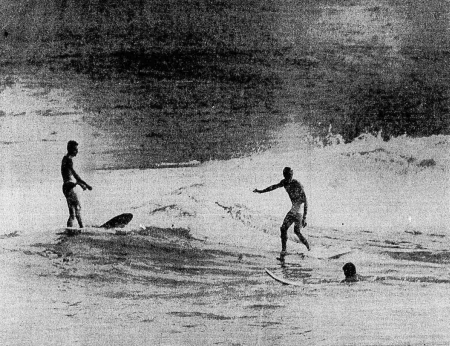 |
Photo sources: (Above left) Marcelo
Kaneca's lendas do surf blog. (Above right) Caderno B. (1964, June 17). Jornal do Surf.
Jornal do Brasil, 74(141), B3, Accessed on January 19, 2014, at memoria.bn.br.
5. I recently read a quote from a 1960s surf traveler, Peter Troy:
"The Italians and the Brazilians were presumably the
best in the world at this back in the 1940s, 50s and 60s and they had
developed a type of surfboard that you could sort of be on, but they
used flippers to improve their kicking, basically so they had more
power and could stay under water longer for the spearfishing
championships."
Do you know if there was there an Italian connection
with Brazil in the 1940s-1950s as Peter Troy suggested?
I don't think so. Jacaré boards were
never used in spearfishing. It was only after the 1990s that
bodyboards started to used for spearfishing from shore.
I came across this interesting blog site, lendas do surf. There
is mention of Peter Troy and "de madeirite no pontão." This site
also has an old photo of a longer style board. A couple of other
names are also mentioned, Francisco Brasileiro
and Raimundo Castro Maia, under the blog heading, "Pré
história do surf- Chicão Brasileiro."
I know this guy from the Lendas do Surfe blog, Marcelo Kaneca. I've
almost bought a SUP board from him a couple of weeks ago. "Madeirite"
was the brand name of the type of plywood used to make the first
surfboards in Brazil. "No Pontão" refers to the break on
Arpoador Beach, the original and most famous Brazilian surfing peak,
AKA amongst the initiated "Arpex." It is the eastern end of Ipanema Beach.
Nowadays very few refer to it as Pontão any longer. The guy on
the BW picture with the wood board is Arduino Colasanti.
Raimundo Castro Maia was a rich guy who loved sea/beach sports. But he
wasn't a thoroughbred surfer. He was involved in the beginning of
spearfishing in Brazil and was a keen deep sea angler as well. I knew
of Francisco Brasileiro, aka Chicão, as a writer/poet and
explorer/bushwhacker. Not that he was a surfer. Perhaps no one knew
about it too. Kaneca mentions that he was the father-in-law of a common
acquaintance of ours, Patricia Young.
6. Telmo Moraes Teixeira Filho from the Cabo Frio Museo do Surf sent
me the following e-mail (March 24, 2013):
"Hello Bob, these boards that
you're talking about were made in Brazil in the 60s and were found in
large quantities in shops for beach supplies very common in the cities
of Santos and São Vicente in the state of Sao Paulo. Note that
almost all were unpainted pine. For that reason few survived because
pine is a favorite wood that termites devour. Regarding madeirites ,
they were made in the the 1950s and were a brand-name of a naval-spec
plywood. [The boards] were made in two shops near Arpoador Beach, and
Ilha do Governador (a district where the international airport is
located) at Rio De Janeiro, respectively, whereas in Sao Paulo they
were made by Procopio which historically produced ping pong tables."
Alo BOB estas placas de que voce está falando eram feitas no
brasil nos anos 60 e eram encontradas em grande quantidade nas lojinhas
de artigos de praia muito comuns nas cidades de santos e sao vicente no
estado de Sao Paulo. observar que quase todas eram na cor natural da
madeira utilizada que era o pinho . Porisso duravavam muito pouco pois
era a madeira predileta dos cupins que a devoravam. Quanto às
madeirits eram feitas na decada de 50 e utilizavam as placas de
madeirit naval que duravam muito . Eram feitas no arpoador e ilha do
governadorno Rio De Janeiro , ja em sao paulo eram feitas pela Procopio
que historicamente produzia mesas de ping pong. Para ver uma delas
acesse museudosurf.com espero tyer contribuido de alguma forma.
Aloha1................ Telmo moraes ).
What is a madeirite?
Madeirite
was an eponym for surfboards, not bellyboards. The madeirites made in
Brazil were solid, laminated plywood. They were devised by Irencyr in
the late-1950s early-1960s, when in a visit to the marine carpenter,
Moacyr Silva, he noticed the special marine plywood boards used to make
boats (brand-name "Madeirite"), which were light and water-resistent
when treated. The shop in Ilha do Governador (Gorvernor Island in
Portuguese) is the same that made the spearfishing boats. Better yet,
he saw how Moacyr could bend the boards. He then realized that it was
what he needed to make a lighter board (in comparison to the "church
doors") and have the nose bent upwards. The madeirites didn't float
well, so they had to surf it standing up with their swim fins on, as
mentioned by Peter Troy! By the way, Troy was the guy who
revolutionized Brazilian surfing because he was the first to do
maneuvers on the board instead of just stand-up and ride the wave
straight.
(Below left) Edgard Fonseca with a
madeirite at Arpoador. Note use of only one swim fin—typically two
fins would be used— however, Edgard shared the pair of fins. Ca. 1966.
(Below right) Irencyr
Beltrão (right) with Ronaldo "Mentira" de Assis, Arpoador Beach, ca. 1959.
"A
foto no anexo sou eu e Ronaldo "Mentira" de Assis com madeirites, surfboard em madeira
projetadas por mim 1959 local praia do Arpoador. eu sou quem
está com a prancha de faixas claras."
|

Irencyr Beltrão: "I was the one who made the "Madeirite," it was a
2.5 cm thick marine-spec plywood, about 50 cm wide and 2.2 m long. It
wasn't hollow, but a solid plywood board instead. It was made in 1959
and had a slight curving on the nose, as you can see at the top of the
photo with Ronaldo "Mentira" de Assis. The bottom had white stripes and you can see the
fin."
Irencyr Beltrão: "Quem fez a madeirite fui eu, era de compensado naval 2,5cm de
espessura mais ou menos 50cm de largura e 2,20m de
comprimento. Não era oca era de compensado naval maciço,
tinha na parte da frente no bico uma pequena curvatura, foi feita em
1959 como você pode ver na foto que mandei, aparece a parte de
cima com Ronaldo "Mentira" de Assis e a parte de baixo prancha com fachas brancas que
está comigo aparece a quilha."
|
|
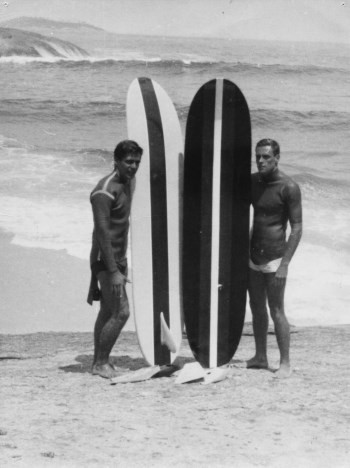
|
Portuguese captions courtesy of Irencyr Beltrão.
(Above left) Rosemberg, Tito. (1966). Surf Photo Archives. Accessed January 15, 2014, from https://www.facebook.com/.
(Above right) Photo courtesy of Irencyr
Beltrão.
7.
I was re-reading your description of a jacaré
board. Is the jacaré board similar to the board pictured
below?
Exactly. The board has a curved-up nose and handles on both sides. The
other characteristics are similar (length, width, thickness). [See Note 4 for more discussion on the jacaré surfriding board.]
A bellyboard
similar to a jacaré board. The logo on this board reads "A Mediterranea."
|
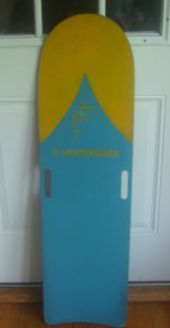
|
|
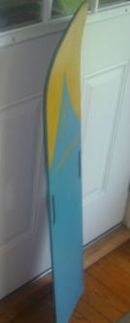
|
Photo courtesy of Mike Shrouds.
In Spanish,
the word for an wooden surfboard was "madera una table de surf." If I
wanted to search or ask about the jacaré boards, do I need to
add a word to "pegar jacaré" so it is clearer that I am
interested in surfing with a board and not just bodysurfing?
No, the correct phrase in Spanish is "tabla de surf de madera." In
Portuguese is "prancha de surfe de madeira." In old publications you
might use "pegar jacaré" (to body surf, but literally means "to
catch alligator", the slang caught on because body surfing may look
like a croc sliding on the surface). Or prancha de jacaré.
Nowadays it it is called surfe de peito (breast surfing) or
bodysurfing. Belly surfing as in the old times never caught on again,
due to the bodyboarding craze.
Were the jacaré boards used much in conjunction with
spearfishing? If so, how?
No. But wooden paddleboards were used by the American spearfishing
pioneers in the 1930s, off San Diego. Since twenty years ago, bodyboards
have been used for spearfishing from shore.
8. How did you first get into spearfishing?
I started when I was 14-years-old (43 years ago) --
when I quit surfing -- but just messing around in the summer with a
couple of buddies. At 16, I got more dedicated, and at 18, I became
very serious, taking part in competitions and all. Ever since, most of
my life, private and professional, has been intrinsically linked to
spearfishing in some way.
9. What depths do you go to? How do you train to hold
your breath?
The shallowest possible to find fish... I don't
do any specific breath-holding work-out. My main focus is to be at ease
in the water, "aquaticity," one calls it. The ability to adapt oneself
to the marine environment. Nevertheless, one must stay fit to freedive
spearfish for few hours; it's an endurance activity. The best training
is spearfishing itself; and, I also do fin swimming, road biking and,
more recently, stand-up paddling.
10. How much of being able to hold your breath
underwater is psychological? Are there any secrets to holding your
breath?
There is always a physical limit related to
one's lung volume and the ability of one's body to withstand working
in a low oxygen environment. The latter could be worked out with
specific training (ALWAYS WITH SUPERVISION). That said, it's common
sense nowadays that the mental attitude and aptitude is the most
important factor for breath-holding, particularly in spearfishing.
It has come to my notice that at least one freediving training agency
has set up a course tailored to big wave surfers.
11. What's your most memorable diving experience?
Having dived all over the world, I've had many.
There wasn't a single day when I've gone to sea that I haven't
experienced something new. But my mindset is that the most memorable
dive would be the next one.
|
NOTES
Note a. Unknown newsreals. (1948). Italian Summer 1948. British Pathé. Retrieved January 14, 2014, from www.britishpathe.com.
Note 1: Telmo Moraes Teixeira Filho from the Cabo Frio surf
museum (24 Mar 2013):
The
small planks were used laying down, hence the expression alligator
surfing, laying with eyes out. Already the madeirites the vast majority
going to the bottom with water until the neck and waited for the wave
when it was next surfer jumped on board paddling and beating the feet
with one foot duck to help get in the mood. Other coseguian already
lying paddling and surfing usually in feet.
As placas pequenas eram usadas deitado, dai vem
a expressao jacaré surfando deitado so com os olhos de fora. Ja as
madeirites a grande maioria ia para o fundo com a agua ate o
pescoço e esperavam a onda quando ela estava pioxima o surfista
pulava sobre a placa remando e batendo os pes um deles com pe de pato
para ajudar a entrar na onda. Outros ja coseguian remar deitados e
surfar normalmente em pei.
Note 2: See the Brazilian surfing blog site, lendas do Surf, for a September 2008 article on Arduíno Colassanti.
Note 3: According to an article written by Irencyr Beltrão in an Internet web site on Brazilian surfing:
They mingled up so the that body-surfers, body-boarders (as in
jacaré) and church-door-surfers were not called surfers but
pegadores de jacaré (alligator catchers). Why? Even today I do
not know! The Arpoador was unlike any other beach. Beachgoers were few.
Most were foreigners, descendants of Germans, Americans, etc
Misturavam-se então aos surfistas de peito, de pranchinha e
porta de igreja, que não chamava-se de surfistas e sim pegadores
de jacaré. Por quê? Até hoje não sei! O
Arpoador era diferente de tudo. Os frequentadores eram poucos. A
maioria era de estrangeiros, descendentes de alemães,
americanos, etc.
Damn, these guys lived defying nature and seas got rough, they would
belly surf over the rocks, called Salceirar*. When the wave came, they
would throw themselves on it, breast on the rocks where the waves
washed, then you had to stand on the stone that dried. The best ones
did it barefooted. (Note: in slightly rough days, when the wave hit and
went over the rocks (which are slopped down), the guy would jump on it
belly first and then stand up on the rock while the wave receded. ...
if one couldn't stand up it they had to swim the hell out of it with
the receding wave so as to not to be hit the next one.)
Caramba, estes caras viviam desafiando a natureza e com o mar meio
virado surfavam de peito nas pedras, chamavam de Salcerar. Quando a
onda vinha, lançavam-se de peito sobre as pedras onde as ondas
lavavam, aí voce tinha que ficar em pé sobre a pedra que
secava. Os melhores faziam descalços.
Source: Beltrão, Irencyr. (2009, October 17). Lendas vivas: Anos dourados do Arpoador. Waves [Internet web page]. Retrieved January 16, 2014, from waves.terra.com.br/.
Arpoador ca. 1965 and madeirites at Arpoador, ca. 1963.
|
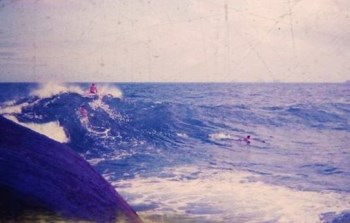
|
|
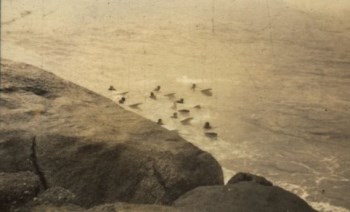
|
Photo source: Rosemberg, Tito. "Surf Photo Archives." Accessed January 15, 2014, from https://www.facebook.com/. |
According to Irencyr Beltrão,
These guys started surfing with boards known at the time (1950s) as
"church door." Then came the "madeirites," and finally, the fiberglass
boards.
Esta galera começou surfando com pranchas conhecidas na
época (anos 50) como "porta de igreja". Depois, vieram as
"madeirites" e, finalmente, as pranchas de fibra de vidro.
Source: Source: Mansur, Wady. (2009, October 11). Lendas do Arpoador: Pioneiros invadem Arpex (RJ). Waves [Internet web page]. Retrieved January 16, 2014, from waves.terra.com.br/.
Arduino Colasanti and Irencyr Beltrão with
swim fins (adapted from spearfishing fins) entangled while riding madeirites
O Pé de pato fazia parte da pesca submarina e foi
adaptado para o surf (pé de pato swinFins) fins para dar entrada
na onda. Neste arquivo estamos juntos nas medeirites eu e Arduino com
pés de pato e em pé, embolados na mesma onda..
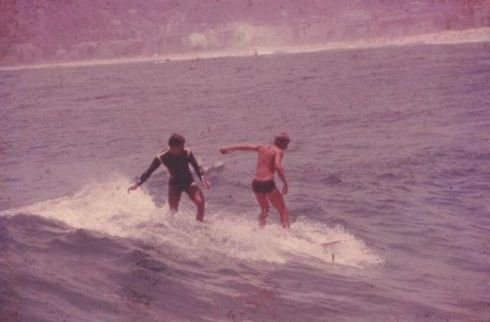
Photo source: Irencyr Beltrão.
Note 4.
It is not certain that
the "A Mediterranea" is an actual jacaré board.
Otavio Pacheco recalls
riding a wooden body board,
called an "Oceania," from around 1958 or 1959 until 1963, when he started
riding a madeirite, before progressing to a fiberglass São
Conrado longboard in 1966. "Oceania was very popular and we used to buy
them in the sports shops. Oceania was also the brand of the factory of
the boards, and many others products. It had 2 little rolls in the
rails, but we didn't use them because we used to hold the nose with the
hands to get more speed. It was about 36 inches long and 18 inches wide with a
lots of curve in the nose and usually they were painted." (Persoanl e-mail, November
13, 2013).
Tito Rosemberg has recalled riding a Balnea brand board, a
board that could be sold in a store on Santa Clara Street that until
recently was still there, but is now a bank. Source: Tito
Rosemberg's Jornal de Viagem.
The paipo interview with surfer historian Reinaldo Andraus includes photos
of jacaré boards. Additionally, Wöllner Veja, a Rio de Janeiro beach and
sportswear store, recently advertised a "prancha para pegar
jacaré," shown below on the left. The ad appeared in Veja, a major weekly news magazine.
(Below left) Wöllner advertisement for a prancha para pegar jacaré with a selling price is R$ 200,00 (about $85 USD).
(Below right) David Szpilman made this board
as he wished to capture a style of surfing he missed.
|
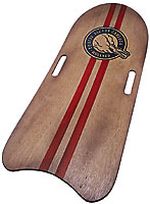
|
|
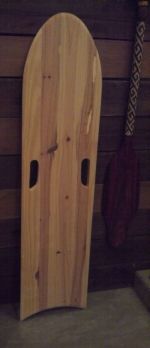
|
(Above left) [Advertisement]. (2014). Veja Rio on-line. Retrieved January 18, 2014, from veja.abril.com.br. (Above right) Photo courtesy of David Szpilman.
|
Other
info:
The assistance of Paulo Donadio Baptista, Irencyr Beltrão,
Cleber Dias, Marcelo Kaneca, Telmo Moraes Teixeira Filho, Otavio
Pacheco, David Szpilman and Tito Rosemberg is gratefully acknowledged. |
|